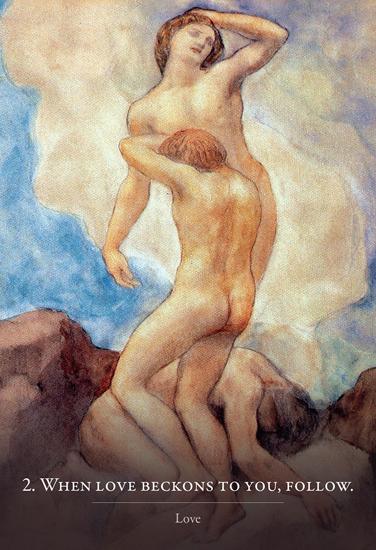You are far far Greater than you know.
First published in 1923, The Prophet by Kahlil Gibran has been read by millions, in over a hundred languages. Its wisdom is a loving welcome home, without boundary, pretense or condition. With thanks to the Gibran National Committee for The Gibran Museum, Toni Carmine Salerno is honored to present 42 of Gibran’s transcendent paintings together with his bestselling work to inspire love, balance and creativity.
This 42 full-color card and guidebook set includes specially selected artwork reproductions, the complete text of The Prophet, an introduction and instructions, making this is a uniquely beautiful treasure for divination, direction, contemplation and insight.
Specs

- 42 cards
- Cards measure: 5.5" x 3.75"
- Box measures: 6.75" x 5"
- Author Toni Carmine Salerno
- Artist Kahlil Gibran
Author
Toni Carmine Salerno is an internationally recognized publisher, artist and bestselling author, whose works emanate healing energy. He is the author of Gaia Oracle, Sacred Earth Oracle, Peace Oracle and a dozen more titles. Toni lives in Melbourne, Australia, where he continues to paint, write, and mentor others.
Artist
Kahil Gibran has been read by Millions, in over a hundred languages. Though he considered himself to be mainly a painter, lived most of his life in the United States, and wrote his best-known works in English, Kahlil Gibran was the key figure in a Romantic movement that transformed Arabic literature in the first half of the twentieth century. Educated in Beirut, Boston, and Paris, Gibran was influenced by the European modernists of the late nineteenth century. His early works were sketches, short stories, poems, and prose poems written in simple language for Arabic newspapers in the United States. These pieces spoke to the experiences and loneliness of Middle Eastern immigrants in the New World. For Arab readers accustomed to the rich but difficult and rigid tradition of Arabic poetry and literary prose, many of the forms and conventions of which went back to pre-Islamic Bedouin poetry, Gibran’s simple and direct style was a revelation and an inspiration. His themes of alienation, disruption, and lost rural beauty and security in a modernizing world also resonated with the experiences of his readers. He quickly found admirers and imitators among Arabic writers, and his reputation as a central figure of Arabic literary modernism has never been challenged.







